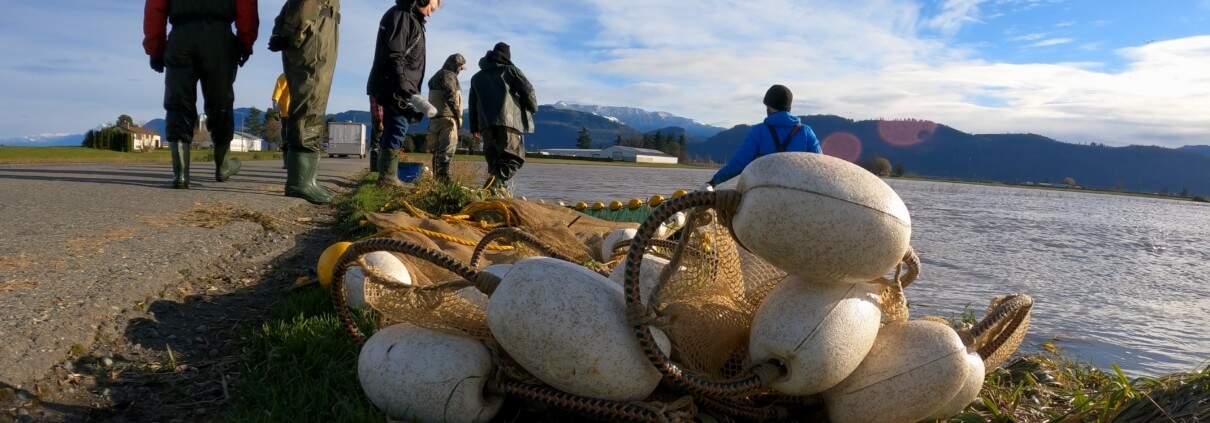Top Post-Flood Priorities for Salmon
We need improved coordinated action for salmon after extreme flooding events impacted salmon habitat across southern British Columbia. We urge officials to address issues requiring immediate action and incorporate salmon conservation into the post-flood response as future infrastructure planning must reflect resilience for human safety, communities and aquatic ecosystems.
The time to move forward with salmon recovery and conservation efforts post-floods is now. The decisions and actions taken today, through to long-term flood recovery, will undoubtedly have an impact on the future health of Pacific salmon. Effective response requires government and all of us to be better prepared to ensure short, mid and long-term strategies are in place, and can be deployed post-flood accordingly.
The Fraser River and its tributaries –areas deeply impacted by recent flood events– make up the most valuable salmon habitat in the world. Infrastructure being rebuilt right now and over the coming months present an essential opportunity to integrate salmon conservation with flood recovery efforts and infrastructure planning.
There are actions we can take that will have great potential to enhance salmon conservation in response to recent flood events and the likelihood of increasing extreme weather events caused by climate change. By ensuring salmon are part of the rebuilding strategies and process, we can protect communities while helping nature and our ecosystems thrive.
Many salmon survived the floods. Some adult salmon, including Coho and chum have been observed trying to spawn in the aftermath. Juvenile salmon have sought refuge in calm side-channels, floodplains, and wetlands, and adult Steelhead are actively seeking safe habitat through the winter before they spawn in the spring.
Support for governing jurisdictions in developing and implementing post-flood strategies will be essential to ensure there is good coordination and collaboration for salmon recovery, water quality testing and habitat improvements during infrastructure rebuilding designs. Through coordination that would include First Nations, federal, provincial and local governments, conservations organizations and communities, we must protect the endangered populations of salmon and help the healthy populations overcome the impacts of climate change.
Here are the top priorities and actions that can make a significant difference:
- Prevent imminent death. Two generations of salmon are at risk. We must identify stranded salmon, ensure they have enough clean water and assess the need for salvage (move the fish to a safe waterway). Salmon have been spotted in ditches, fields, swimming across streets and in backyards, displaced by the rapid movement of water and floods. This crisis triggered the Pacific Salmon Foundation, the Lower Fraser Fisheries Alliance, Sema:th (Sumas) Nation and Sto:Lo Nation to collaborate and rescue stranded fish from flooded fields in the Sumas Prairie.
- Monitor, address and protect water quality. Contaminants in rivers and flooded areas remain a concern. Monitoring water quality and addressing contaminated areas with urgency is vital to salmon health and survival.
- Repair habitat that is at high risk of further impact from another weather event, such as heavy rain or snow. This requires identifying at-risk salmon habitat, such as channels with high levels of debris that can cause blockages to water flow or leave fish stranded, and rapidly working to restore the habitat.
- Salmon safe infrastructure. Immediate work underway to rebuild roads, rails, pipelines, etc. is taking place in highly important salmon habitat. Rebuilding work underway on highways and pipelines could include simple, high-value habitat remediation in streams and side channels. Decisions and actions underway now can include the opportunity to save and protect salmon. Mid and long-term infrastructure such as; dikes, pumps, roads, pipelines, railways –major infrastructure that our communities depend on –all directly intersect with salmon migration and habitat. There is a finite window of time that will see rebuilding efforts either enhance salmon conservation or permanently harm their future. There are ways to rebuild that simultaneously to protect salmon, including large culverts to allow salmon passage, fish-friendly pumps, and reconnecting tributaries through either fish-friendly infrastructure or reconnecting flood habitat.
- Nature-based solutions. We must acknowledge that flooding is a natural event and anticipate that floods will increase in frequency and severity due to climate change and weather events. Building back with resilience bases planning and decisions with acknowledgement that floods are likely to occur again. There are proven nature-based solutions that can decrease the risk of catastrophic flooding while enhancing valuable salmon habitat. The value of sloughs, side-channel streams, and ‘flood-resilient’ farmland, are compatible with occasional flooding and are salmon-friendly.
The immediate challenge is timely coordination across the entities involved in flood recovery to ensure that infrastructure rebuilding efforts improve migration and habitat areas for our wild salmon, and use opportunities to support and advance salmon conservation recovery efforts.
To reduce harm, rebuilding efforts must avoid things such as: digging up habitat where salmon may be trying to spawn; inadvertently filling in places salmon have sought as refuge; isolating areas salmon are in from the river without salvaging the fish; constricting floodplains; and removing riparian vegetation.



